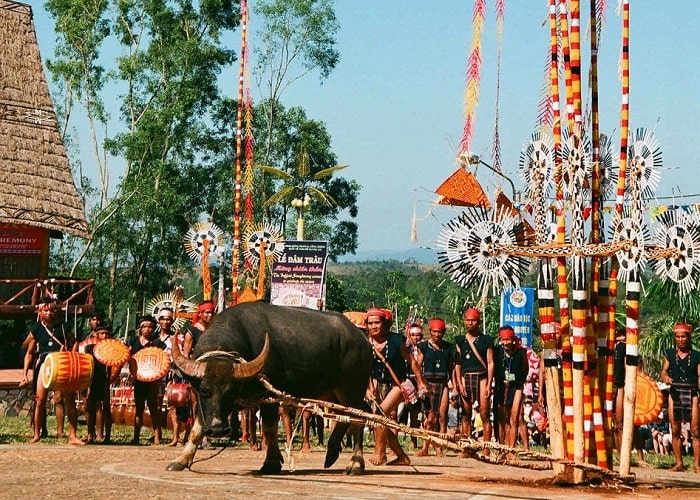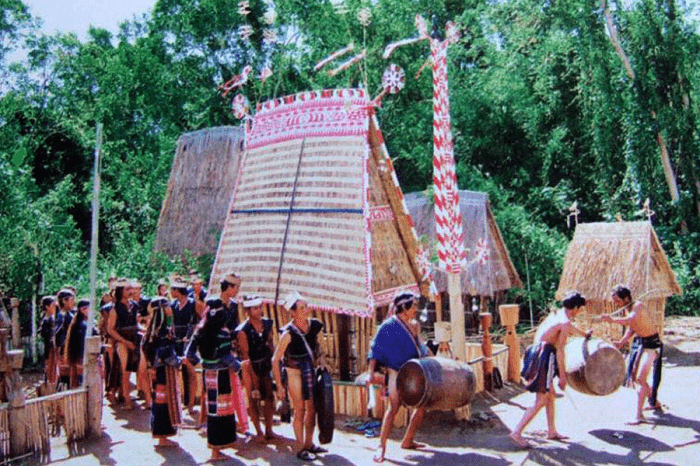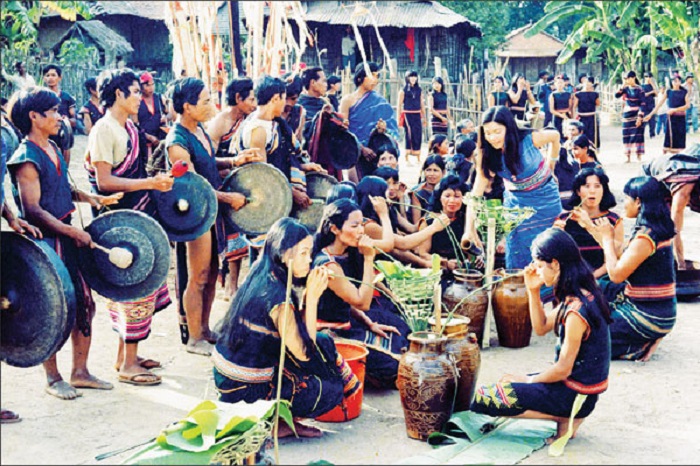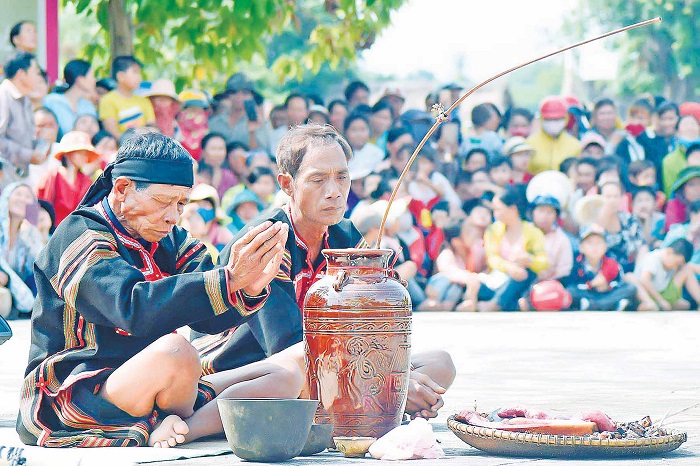
Bringing the characteristics of the village culture of Tay Nguyen village, Gia Lai has many special festivals held during the year such as Dam Trau festival, Leaving Ma ceremony, Com Moi ceremony …
Some special Gia Lai festivals
Buffalo stabbing ceremony
The Dam Trau ceremony usually takes place from the beginning of December of the previous year to the March of the next lunar year, the festival is held by the Gia Rai and Ba Na people at the communal house with the contribution of the whole village. The Ba Na people organize for 3 days, while Gia Rai people organize it for one and a half days. Buffalo was tied around the tree, a muscular young man was sent to take the responsibility of stabbing Buffalo, then using blood mixed with wine to worship Giang (god).  The buffalo’s blood was stabbed and used to sacrifice Giang
The buffalo’s blood was stabbed and used to sacrifice Giang
This Gia Lai festival is held on the occasion of celebrating the victory, celebrating the victory of the community, inauguration of the communal house, a ceremony to pray for security, a ceremony to remove bad omen, bad luck for the whole village or to give thanks to the gods.
Grave removal ceremony
Leaving Ma festival (Po Thi festival) is the biggest and most quintessential festival of the Central Highlands festivals . When the Hmong tree at the beginning of the village and Edap trees in the middle of the village bloom and bloom (from November to the end of April of the following calendar year), that is when the Ba Na and Gia Rai people in Gia Lai hold the Abandoning ceremony . This is a festival meant to see off the souls of the dead to their ancestors, usually taking place in 3 days. The Leaving Grave Ceremony goes through three steps: Building a tomb, the removal ceremony and the pot washing ceremony (liberating the soul). The festival is deeply humane: Rebirth for the dead and free the living from ties with the dead. The ceremony to leave the graveyard is a festival with profound human nature
The ceremony to leave the graveyard is a festival with profound human nature
New rice ceremony
Once a year, in January or February of solar calendar, when all the ripe rice in the fields has been harvested, the villagers prepare gifts to celebrate new rice. The new rice ceremony is actually to celebrate the new harvest season, to pray for the upland fields to be harvested, to harvest more paddy rice and more importantly to give thanks to the god of rice, to honor the grain given by the Giàng so the custom of worshiping Giang and worshiping. God of heaven, god of rivers and streams, god of rain, god of crops is focused. A new rice ceremony is held in a communal house or a private house, when the owner will bring new relatives and friends to join the family for a meal; Organizing new rice depends on the ability to harvest more – less of the family, but the more crowded house, the more honored it is. The new rice celebration is a festival bearing the belief of all living beings. The new rice festival is the most crowded and bustling festival of the year for the Central Highlands people
The new rice festival is the most crowded and bustling festival of the year for the Central Highlands people
Rain praying ceremony
A typical Gia Lai festival of the Gia Rai peoplebefore the planting season, sometimes it is dry during the growing season. Depending on each ethnic group, the rain praying ceremony of different ethnic groups can be held in each family, organized according to the community. Normally, the ceremony takes place at the wharf, a patch of soil is covered up to represent the field, on display of offerings including: a pot of wine, a basket with meat hanging around the rim, 2 pieces of short cut umbrellas. wine placed outside the base In addition, there are meat and 3 cork representing rainwater containers. Along with the development of irrigation and irrigation, crops are also supplied with enough water, rain praying is no longer an essential need of Gia Lai people, rain praying ceremony is also less and less absent. Currently, this practice only continues every year in Plei Rbai village, Ia Piar commune, Phu Thien district every April. To restore the rain praying ceremony in Phu Thien district
To restore the rain praying ceremony in Phu Thien district
Water wharf worshiping ceremony
Water drops for Ba Na and Gia Rai ethnic minorities in the Central Highlands is a very unique cultural symbol, it is associated with the cultural, spiritual and spiritual life of the people. They hold a waterfront ceremony every year after the harvest season to pray for good rain, good crops, and a warm and happy life. The festival started with the ceremony of worshiping the ancestors of the ancestors, followed by worshiping Giang to pray for rain. At the end of the ceremony, the girls in traditional costumes together with everyone followed in the footsteps of the priest to the village’s waterfront to return to the fresh and fresh water gourds in joy. After that, everyone gathered together to drink Can wine in the bustling sound of Tay Nguyen gongs. This is a form of community cultural activities that has a positive meaning in the spiritual and spiritual life of the Ede ethnic group. The wharf is like the soul of Ede village
The wharf is like the soul of Ede village
Although over time, the lives of ethnic minorities in Gia Lai have increased civilization and progress; Many festivals are no longer original, but in general, these are still specific characteristics in the Central Highlands festival culture that need to be preserved and preserved.
